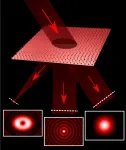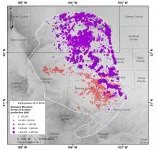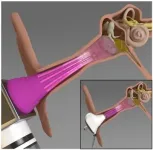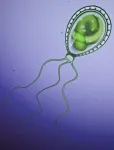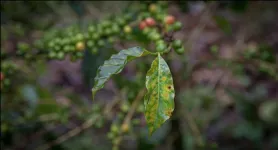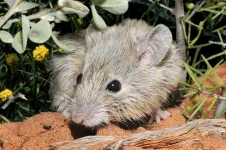How to build a better wind farm
It is imperative that we understand the relationship between turbine placement and maximum energy extraction
2021-06-28
(Press-News.org) Washington, DC--Location, location, location--when it comes to the placement of wind turbines, the old real estate adage applies, according to new research published in Proceedings of the National Academy of Sciences by Carnegie's Enrico Antonini and Ken Caldeira.
Turbines convert the wind's kinetic energy into electrical energy as they turn. However, the very act of installing turbines affects our ability to harness the wind's power. As a turbine engages with the wind, it affects it. One turbine's extraction of energy from the wind influences the ability of its neighbors to do the same.
"Wind is never going to 'run dry' as an energy resource, but our ability to harvest it isn't infinitely scalable either," Antonini explained. "When wind turbines are clustered in large groups, their performance is diminished and the rate at which they extract energy is reduced."
Antonini and Caldeira set out to determine how large a wind farm can be before its generation capability per unit of land reaches the limits of energy replenishment, as well as how much of a "wind shadow" large farms cast, which would have a negative effect on any neighboring downwind installations.
"As we move away from fossil fuels, some scenarios predict wind farms could supply as much as one-third of global energy by 2050," Caldeira said. "So, it is imperative that we understand the relationship between turbine placement and maximum energy extraction."
It takes time for the wind to return to normal strength after some of its kinetic energy has been extracted by a wind farm. How quickly wind can recover from encountering a wind turbine is related to the wind farm's latitude and the Earth's rotation, Antonini and Caldeira said. Previous studies on wind power generation have noticed wakes behind large wind farms, so Antonini and Caldeira developed a theoretical understanding of the fundamental controls on the size of these wakes.
The size of a large wind farm's wake is related the speed of the overlying winds, as well as to the amount of time it takes pressure differences in Earth's atmosphere to replenish the energy that was extracted by the turbines. Antonini and Caldeira's work indicates that these factors should be considered when determining the size and placement of wind farms under different conditions.
For example, they found that turbines in areas with high winds are more likely to be affected by their upstream neighbors than those in areas with weaker winds. Also, wind farms that are closer to the equator are more likely to be negatively impacted by the wind shadow of upstream wind farms than are wind farms that are closer to the poles.
"Wind energy is a potential source of large amounts of carbon-emission-free energy," Caldeira said. "But to get the most out of this resource, we need to think about how other wind farms might affect us, and how we might affect other wind farms."
One idea the authors suggested is that constructing multiple small wind farms with space for wind recovery in between them could potentially be a more effective strategy in some locations than building one massive wind farm, although more research is needed.
"We hope this work will enable the builders and managers of wind turbine installations to design the best possible scenario for maximum wind power generation," Antonini said.
INFORMATION:
This work was funded by a gift from Gates Ventures LLC to the Carnegie Institution for Science.
The Carnegie Institution for Science (carnegiescience.edu) is a private, nonprofit organization headquartered in Washington, D.C., with three research divisions on both coasts. Since its founding in 1902, the Carnegie Institution has been a pioneering force in basic scientific research. Carnegie scientists are leaders in the life and environmental sciences, Earth and planetary science, and astronomy and astrophysics.
ELSE PRESS RELEASES FROM THIS DATE:
2021-06-28
The ability to precisely control the various properties of laser light is critical to much of the technology that we use today, from commercial virtual reality (VR) headsets to microscopic imaging for biomedical research. Many of today's laser systems rely on separate, rotating components to control the wavelength, shape and power of a laser beam, making these devices bulky and difficult to maintain.
Now, researchers at the Harvard John A. Paulson School of Engineering and Applied Sciences have developed a single metasurface that can effectively tune the different properties of laser light, ...
2021-06-28
In the context of recent debate over the FDA's approval of aducanumab, it's refreshing to learn about a model of Alzheimer's neurodegeneration that doesn't start with the pathogenic proteins amyloid or Tau.
A new paper in Alzheimer's & Dementia from Emory neuroscientist Shan Ping Yu and colleagues focuses on an unusual member of the family of NMDA receptors, signaling molecules that are critical for learning and memory. Their findings contain leads for additional research on Alzheimer's, including drugs that are already FDA-approved that could be used preventively, and genes ...
2021-06-28
Deployable structures -- objects that transition from a compact state to an expanded one -- are used everywhere from backyards to Mars. But as anyone who has ever struggled to open an uncooperative folding chair knows, transforming two-dimensional forms into three-dimensional structures is sometimes a challenge.
Now, researchers from the Harvard John A. Paulson School of Engineering and Applied Sciences (SEAS) and the Harvard Graduate School of Design have developed a deployable system that is light, compact, inexpensive, easy to manufacture, and, most importantly, easy to deploy. By harnessing the mechanical instabilities in curved beams, the system can transform objects into elaborate and customizable 3D configurations on a range of scales, from large-scale furniture to small medical ...
2021-06-28
Boulder, Colo., USA: Subsurface carbon sequestration--storing carbon in
rocks deep underground--offers a partial solution for removing carbon from
the atmosphere. Used alongside emissions reductions, geologic carbon
sequestration could help mitigate anthropogenic climate change. But like
other underground operations, it comes with risks--including earthquakes.
Geophysicists are still working to understand what can trigger
human-induced earthquakes, which have been documented since the 1960s. A
new study, published in Geology on Thursday, explores why part of
a heavily produced oilfield in the U.S. has ...
2021-06-28
Middle ear infections, also known as otitis media, affect more than 80% of the children in the U.S. In a new study, researchers have designed a miniaturized 3D-printed device to inactivate Pseudomonas aeruginosa, a common bacterium that causes the infection.
The device--a microplasma jet array--generates plasma, which is composed of charged particles and reactive molecules that have been previously shown to inactivate various pathogens. "This is the first time anyone has tried treating middle ear infections using plasma technology," said Jungeun Won, a graduate student in the Boppart lab. "Usually, the treatment involves using ...
2021-06-28
HUNTINGTON, W.Va. - According to researchers at Marshall University, a maternal diet rich in Omega-3 fatty acids protects from breast cancer development in offspring. In a new study recently published by Frontiers in Cell and Developmental Biology, researchers noted a significant difference in mice from mothers that were fed a diet rich in canola oil, compared with mothers fed a diet rich in corn oil. A maternal Omega 3-rich diet affected genome-wide epigenetic landscape changes in offspring and potentially modulated gene expression patterns.
Dr. Ata Abbas, a former postdoctoral research fellow in Marshall's Department of Biological Sciences, headed a research team under the leadership ...
2021-06-28
New Brunswick, N.J. (June 28, 2021) - A Rutgers-led study sheds new light on the evolution of photosynthesis in plants and algae, which could help to improve crop production.
The paper appears in the journal New Phytologist.
The scientists reviewed research on the photosynthetic amoeba Paulinella, which is a model to explore a fundamental question about eukaryote evolution: why was there a single origin of algae and plants? That is, why did photosynthesis by primary plastid endosymbiosis not originate multiple times in the tree of life?
Photosynthesis is the process by which plants and other organisms use sunlight to synthesize ...
2021-06-28
A first-of-its-kind longitudinal study of infant curiosity found that months-old babies most captivated by magic tricks became the most curious toddlers, suggesting a pre-verbal baby's level of interest in surprising aspects of the world remains constant over time and could predict their future cognitive ability.
"Something about a baby's curiosity about magic tricks is predicting how curious they become as preschoolers," said Lisa Feigenson, co-director of the Johns Hopkins University Laboratory for Child Development. "What the data suggest is that some three-year-olds have a leg up or seem particularly well positioned to learn a lot about the world."
The findings appear today in Proceedings of the National Academy of Sciences.
Until this study, little was known about curiosity ...
2021-06-28
New Brunswick, N.J. (June 28, 2021) - COVID-19's socio-economic effects will likely cause another severe production crisis in the coffee industry, according to a Rutgers University-led study.
The study, which appears in the journal Proceedings of the National Academy of Sciences, included researchers from the University of Arizona, University of Hawaii at Hilo, CIRAD, Santa Clara University, Purdue University West Lafayette and University of Exeter.
"Any major impacts in the global coffee industry will have serious implications for millions of people across the globe, including the coffee retail ...
2021-06-28
An Australian mammal thought to have been wiped out over 150 years ago can now be crossed off our list of extinct animals, following a new study.
Researchers compared DNA samples fromeight extinct Australian rodents, as well as 42 of their living relatives, to look at the decline of native species since the arrival of Europeans in Australia.
The study showed the extinctGould's mouse was indistinguishable from the Shark Bay mouse, still found on several small islands off the coast of Western Australia.
According to lead author Dr Emily Roycroft ...
LAST 30 PRESS RELEASES:
[Press-News.org] How to build a better wind farm
It is imperative that we understand the relationship between turbine placement and maximum energy extraction
